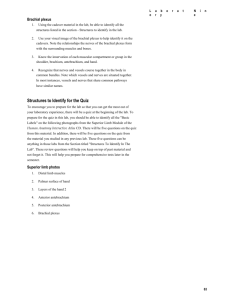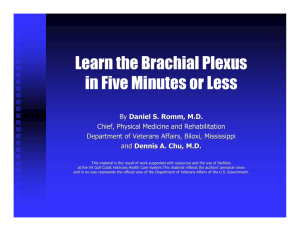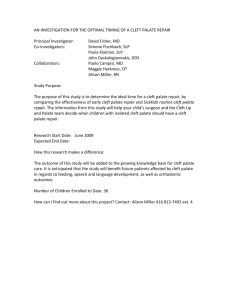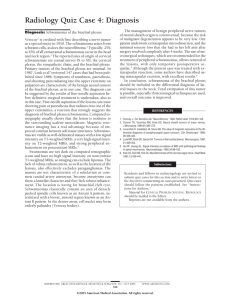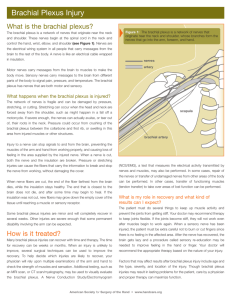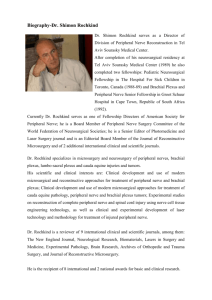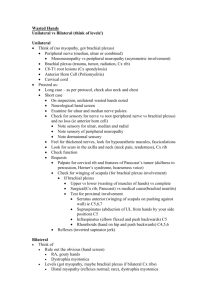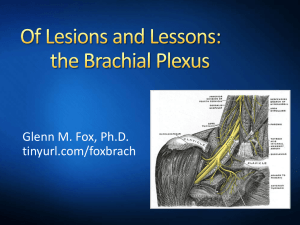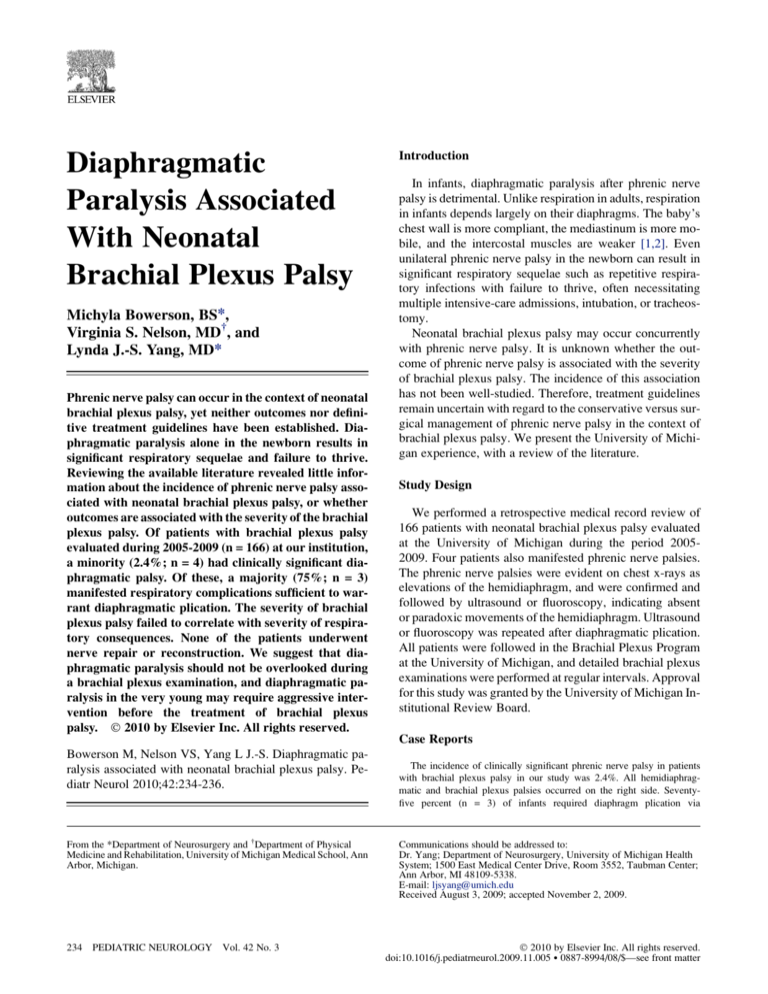
Diaphragmatic
Paralysis Associated
With Neonatal
Brachial Plexus Palsy
Michyla Bowerson, BS*,
Virginia S. Nelson, MD†, and
Lynda J.-S. Yang, MD*
Phrenic nerve palsy can occur in the context of neonatal
brachial plexus palsy, yet neither outcomes nor definitive treatment guidelines have been established. Diaphragmatic paralysis alone in the newborn results in
significant respiratory sequelae and failure to thrive.
Reviewing the available literature revealed little information about the incidence of phrenic nerve palsy associated with neonatal brachial plexus palsy, or whether
outcomes are associated with the severity of the brachial
plexus palsy. Of patients with brachial plexus palsy
evaluated during 2005-2009 (n = 166) at our institution,
a minority (2.4%; n = 4) had clinically significant diaphragmatic palsy. Of these, a majority (75%; n = 3)
manifested respiratory complications sufficient to warrant diaphragmatic plication. The severity of brachial
plexus palsy failed to correlate with severity of respiratory consequences. None of the patients underwent
nerve repair or reconstruction. We suggest that diaphragmatic paralysis should not be overlooked during
a brachial plexus examination, and diaphragmatic paralysis in the very young may require aggressive intervention before the treatment of brachial plexus
palsy. Ó 2010 by Elsevier Inc. All rights reserved.
Introduction
In infants, diaphragmatic paralysis after phrenic nerve
palsy is detrimental. Unlike respiration in adults, respiration
in infants depends largely on their diaphragms. The baby’s
chest wall is more compliant, the mediastinum is more mobile, and the intercostal muscles are weaker [1,2]. Even
unilateral phrenic nerve palsy in the newborn can result in
significant respiratory sequelae such as repetitive respiratory infections with failure to thrive, often necessitating
multiple intensive-care admissions, intubation, or tracheostomy.
Neonatal brachial plexus palsy may occur concurrently
with phrenic nerve palsy. It is unknown whether the outcome of phrenic nerve palsy is associated with the severity
of brachial plexus palsy. The incidence of this association
has not been well-studied. Therefore, treatment guidelines
remain uncertain with regard to the conservative versus surgical management of phrenic nerve palsy in the context of
brachial plexus palsy. We present the University of Michigan experience, with a review of the literature.
Study Design
We performed a retrospective medical record review of
166 patients with neonatal brachial plexus palsy evaluated
at the University of Michigan during the period 20052009. Four patients also manifested phrenic nerve palsies.
The phrenic nerve palsies were evident on chest x-rays as
elevations of the hemidiaphragm, and were confirmed and
followed by ultrasound or fluoroscopy, indicating absent
or paradoxic movements of the hemidiaphragm. Ultrasound
or fluoroscopy was repeated after diaphragmatic plication.
All patients were followed in the Brachial Plexus Program
at the University of Michigan, and detailed brachial plexus
examinations were performed at regular intervals. Approval
for this study was granted by the University of Michigan Institutional Review Board.
Case Reports
Bowerson M, Nelson VS, Yang L J.-S. Diaphragmatic paralysis associated with neonatal brachial plexus palsy. Pediatr Neurol 2010;42:234-236.
From the *Department of Neurosurgery and †Department of Physical
Medicine and Rehabilitation, University of Michigan Medical School, Ann
Arbor, Michigan.
234 PEDIATRIC NEUROLOGY Vol. 42 No. 3
The incidence of clinically significant phrenic nerve palsy in patients
with brachial plexus palsy in our study was 2.4%. All hemidiaphragmatic and brachial plexus palsies occurred on the right side. Seventyfive percent (n = 3) of infants required diaphragm plication via
Communications should be addressed to:
Dr. Yang; Department of Neurosurgery, University of Michigan Health
System; 1500 East Medical Center Drive, Room 3552, Taubman Center;
Ann Arbor, MI 48109-5338.
E-mail: ljsyang@umich.edu
Received August 3, 2009; accepted November 2, 2009.
Ó 2010 by Elsevier Inc. All rights reserved.
doi:10.1016/j.pediatrneurol.2009.11.005 0887-8994/08/$—see front matter
thoracoscopy, but no patients required surgical nerve repair or reconstruction (biceps muscle strength was used as a standard indicator for
recovery from brachial plexus palsy). In patients undergoing thoracoscopic plication, supplemental oxygen and nasogastric feeds were discontinued by 1 month postoperatively, with subsequent steady weight
gain. One patient presented with temporary respiratory distress, but
did not require surgical intervention. Risk factors for a concurrent presentation of brachial plexus palsy and phrenic nerve palsy included
breech presentation, forceps extraction, and shoulder dystocia. Increased
birth weight was not evident in these patients. Details of patients’ medical courses are presented below.
Patient 1
The patient was a girl weighing 3.6 kg, born to a gravida 2, para 1 mother
at term, aided by the use of forceps. The infant presented with right diaphragmatic paralysis associated with brachial plexus palsy (Narakas grade
II) [3], resulting in moderate respiratory insufficiency. Her Apgar scores
were 4 at 5 minutes and 9 at 10 minutes. She was hospitalized for 1 month
in the intensive care unit, required continuous supplementary oxygen, and
was discharged with oxygen via nasal cannula (1/16 L/minute). Because of
her respiratory difficulties, the patient was unable to take food orally, and
required placement of a nasogastric tube because of failure to thrive.
The patient presented at the Brachial Plexus Program at age 1 month.
She manifested tachypnea at 66-100 breaths per minute, with difficulty
feeding (weight, 3.94 kg; 22nd centile), and with antigravity biceps power.
Although her right arm improved, repeated fluoroscopy demonstrated persistent paralysis of the right hemidiaphragm. Given her tenuous respiratory
status and the requirement for nasogastric feedings, the patient underwent
thoracoscopic plication of the right hemidiaphragm at age 2 months. Immediate improvement in respiratory effort was evident, with a normalized respiratory rate and less abdominal effort. She was weaned from
supplementary oxygen by postoperative day 3, and from nasogastric feedings within 1 month. At age 11 months, she underwent a normal right upper-extremity examination with 5/5 biceps strength, indicating resolution
of the brachial plexus palsy.
Patient 2
The second patient was a boy weighing 3.7 kg, born to a 33-year-old
gravida 2, para 2 mother via spontaneous vaginal delivery at term, complicated by shoulder dystocia and diaphragmatic palsy associated with brachial plexus palsy (Narakas grade I) [3]. His Apgar scores were 5 at 5
minutes and 10 at 10 minutes. He required intensive care for 16 days
with oxygen therapy via nasal cannula, and was discharged with an oxygen
requirement of 1/4 to 1/2 L/minute. He initially did well, with adequate oral
nutrition intake, stable oxygen requirement, and appropriate weight gain.
However, he required hospital readmission at age 27 days for labored
breathing with worsening tachypnea (80-100 breaths per minute) and
poor feeding, necessitating intubation and nasogastric feedings. The patient
was diagnosed with pneumonia, and initial attempts to extubate resulted in
a small pneumothorax, atelectasis, and intermittent desaturations. He was
extubated on hospital day 6, but tachypnea persisted, with increasing respiratory labor. An ultrasound of the chest revealed no improvement in diaphragmatic function. Therefore, the patient underwent diaphragmatic
plication at age 35 days. Supplementary oxygen and a nasogastric tube
were discontinued by postoperative day 5. After plication, the patient manifested no additional respiratory difficulties, and his respiratory rate stabilized between 60-70 breaths per minute.
At age 5.5 months, the patient demonstrated a normal passive range of
motion in his right arm, and his active range of motion continued to exhibit
improvement. His biceps strength was 4+/5.
Patient 3
The patient was a boy weighing 2.87 kg, born at term to a 40-year-old
gravida 2, para 1 mother via forceps-assisted vaginal delivery for fetal
tachycardia. The pregnancy was complicated by gestational diabetes requiring insulin, bipolar disorder, and maternal chorioamnionitis postpartum. His Apgar scores were 4 at 5 minutes and 8 at 10 minutes. He was
diagnosed with right brachial plexus palsy (Narakas grade II) [3] and
phrenic nerve palsy with right hemidiaphragm paralysis. He was hospitalized for sepsis, presumably resulting from the presence of maternal chorioamnionitis.
The patient was admitted to the intensive care unit at age 5 days because
of hypoxia and physiologic jaundice. He required 1/4 L/minute oxygen via
nasal cannula, and was discharged home with oxygen. At age 15 days, the
patient was readmitted to the intensive care unit with fever, lethargy, tachycardia, tachypnea, and respiratory distress. A nasogastric tube was placed
for feeding to avoid aspiration resulting from tachypnea. He remained tachypneic on 1 L/minute oxygen, with failure to thrive. At age 1 month,
the patient underwent diaphragmatic plication. His respiratory rate slowly
normalized with 1/4 L/minute oxygen, and his oral intake increased, soon
leading to discontinuation of the nasogastric tube. The brachial plexus
palsy continued to resolve spontaneously. At age 7 months, the patient’s
biceps strength was 4/5.
Patient 4
The patient was a boy, weighing 1.98 kg with right brachial plexus palsy
and phrenic nerve palsy diagnosed by chest x-ray, born at 36 weeks of gestation to a gravida 1, para 1 16-year-old mother via spontaneous vaginal delivery. The pregnancy was complicated by intrauterine growth retardation
and breech presentation, with possible head entrapment and birth asphyxia.
His Apgar scores were 3 at 5 minutes and 4 at 10 minutes. The patient required positive pressure ventilation, and was subsequently intubated because of poor respiratory effort. He underwent selective cerebral
hypothermia for 72 hours. He remained on continuous mechanical ventilation until age 8 days, and on oxygen until age 13 days. He was discharged
after 17 days in the intensive care unit, and required no additional admissions.
The patient had continued respiratory difficulty requiring nebulized albuterol treatments three to four times per week, with one episode of pneumonia
at age 5 months that resolved quickly with oral antibiotics. He was referred to
the Brachial Plexus Program at age 9 months. By that time, his brachial plexopathy (initially Narakas grade III) [3] was resolving spontaneously. His biceps strength was 4/5.
Discussion
The incidence of perinatal diaphragmatic paralysis is approximately 1 in 15,000 to 1 in 30,000 live births, and mortality is estimated at 10-15% [4]. Of 166 patients in our
clinic with neonatal brachial plexus palsy, the incidence
of concurrent ipsilateral phrenic nerve palsy was 2.4%
(n = 4), and the majority of these patients required diaphragmatic placation for continued respiratory distress. Al-Qattan
et al. [5] reported an incidence of 4.2%, but respiratory outcomes were not addressed. Conversely, 66.7-71.4% of patients manifesting phrenic nerve palsies were reported to
demonstrate some degree of brachial plexus palsy [4,6].
Risk factors for the simultaneous occurrence of both
phrenic nerve and brachial plexus palsies include breech
presentation, maternal diabetes, forceps or vacuum extraction, and shoulder dystocia. Other studies reported breech
presentation as a risk for concurrent brachial plexus and
phrenic nerve palsies [7,8]. None of the patients in our series were born via cesarean section. Cesarean sections
may constitute a protective factor, decreasing the risk of
birth trauma. Other potential risk factors include uterine
Bowerson et al: Diaphragmatic Paralysis and Brachial Plexus Palsy
235
malformation [9], resulting in the intrauterine onset of brachial plexus and phrenic nerve palsy, and macrosomia [4].
We did not find increased birth weight to be a risk factor for
the concurrent presentation of both conditions, although increased birth weight was reported to be a risk factor for neonatal brachial plexus palsy alone. The right hemidiaphragm
was more commonly affected in our patients, in concordance with other reports (70-80%) [4,10].
A diagnosis of phrenic nerve palsy is suspected when
a patient experiences respiratory distress at birth, and subsequent imaging studies reveal an elevated hemidiaphragm.
Early fluoroscopy or ultrasound is recommended to assess
diaphragmatic movement. Ultrasound is the preferred diagnostic modality, because it does not involve radiation [4,11].
Treatment guidelines for the management of patients
manifesting continued respiratory distress resulting from
diaphragmatic paralysis have yet to be established. Initial
supportive management usually includes mechanical ventilation, oxygen, and nasogastric tube feedings to avoid failure to thrive and to ensure weight gain. A viable option is
surgical management with diaphragmatic plication via thoracoscopy or thoracostomy. We suggest that indications for
surgical intervention in phrenic nerve palsy with associated
brachial plexus palsy include a continued need for respiratory or ventilatory support, and failure to thrive within the
first few months after birth. The timing for diaphragmatic
plication remains controversial, because the risks associated
with surgical intervention are greater at a younger patient
age, but efforts have been increasing to perform plication
at the earliest sign of respiratory distress [4,12]. Stramrood
et al. [4] reported that when plication was performed at
around age 20 days, patients rapidly improved. In our study,
3 of 4 patients underwent diaphragmatic plication at age 1-2
months, and experienced significant, rapid respiratory improvement postoperatively. In addition, repeated admissions to the intensive care unit for respiratory distress
necessitate surgical intervention.
Predicting the respiratory outcomes of diaphragmatic paralysis based on the occurrence or severity of brachial
plexus palsy has not been investigated. The phrenic nerve
originates at the level of C4 in the cervical spine, with contributions from the C3, C4, and C5 nerve roots. Concurrent
phrenic nerve injury and brachial plexus palsy (at C5, C6,
possibly C7, C8, and T1) indicate a wider proximal zone
of injury, which was thought to indicate poorer outcomes.
Our study illustrates that the severity of respiratory signs resulting from phrenic nerve palsy does not correlate with the
severity of the brachial plexus palsy, because the brachial
plexus palsies in all four of our patients resolved spontane-
236 PEDIATRIC NEUROLOGY Vol. 42 No. 3
ously. Recovery of arm function has little value in framing
a prognosis in the context of phrenic nerve palsy. The patient with the most severe brachial plexus palsy (from C5
to T1) was the only patient who did not require diaphragmatic plication. Similarly, Al-Qattan et al. [5] reported
that the presence of phrenic nerve palsy in newborn babies
with brachial plexus palsy did not imply worse spontaneous
motor recovery of the limb.
Diaphragmatic paralysis resulting from phrenic nerve
palsy in the context of neonatal brachial plexus palsy can
lead to dire consequences. Our data indicate that spontaneous recovery from brachial plexus palsy does not prognosticate a better respiratory outcome from phrenic nerve palsy.
Early evaluations of patients with brachial plexus palsy
should include an investigation of the phrenic nerve. The indications and timing for diaphragmatic plication are not established. However, accumulating data suggest that earlier
interventions improve outcomes. Further investigations
will be necessary to develop more definitive guidelines
for the treatment of this condition.
References
[1] Meyers BF, Kozower BD. ACS Surgery: Principles and Practices,
6th ed., Chapter 4.6. Philadelphia: B.C. Decker Inc., 2008, http://www.
acssurgery.com/acs/Chapters/ch0406.htm.
[2] Simansky DA, Paley M, Refaely Y, Yellin A. Diaphragm plication following phrenic nerve injury: A comparison of paediatric and adult
patients. Thorax 2002;57:613-6.
[3] Zafeiriou DI, Psychogiou K. Obstetrical brachial plexus palsy. Pediatr Neurol 2008;38:235-42.
[4] Stramrood CA, Blok CA, van der Zee DC, Gerards LJ. Neonatal
phrenic nerve injury due to traumatic delivery. J Perinat Med 2009;37:293-6.
[5] Al-Qattan MM, Clarke HM, Curtis CG. The prognostic value of
concurrent phrenic nerve palsy in newborn children with Erb’s palsy. J
Hand Surg [Br] 1998;23:225.
[6] Hughes CA, Harley EH, Milmoe G, Bala R, Martorella A. Birth trauma
in the head and neck. Arch Otolaryngol Head Neck Surg 1999;125:193-9.
[7] Al-Qattan MM. Obstetric brachial plexus palsy associated with
breech delivery. Ann Plast Surg 2003;51:257-65.
[8] Blaauw G, Slooff ACJ, Muhlig RS. Results of surgery after breech
delivery. In: Gilbert A, editor. Brachial plexus injuries. Florence, KY: Taylor & Francis, 2001:217-24.
[9] Dunn DW, Engle WA. Brachial plexus palsy: Intrauterine onset.
Pediatr Neurol 1985;1:367-9.
[10] Rennie JM. Respiratory problems of infants with neurological
disease. In: Greenough A, Milner AD, editors. Neonatal respiratory disorders. London: Hodder Arnold, 2003:254.
[11] Lemmer J, Stiller B, Heise G, et al. Postoperative phrenic nerve
palsy: Early clinical implications and management. Intensive Care Med
2006;32:1227-33.
[12] Tsugawa C, Kimura K, Nishijima E, Muraji T, Yamaguchi M.
Diaphragmatic eventration in infants and children: Is conservative treatment justified? J Pediatr Surg 1997;32:1643-4.


